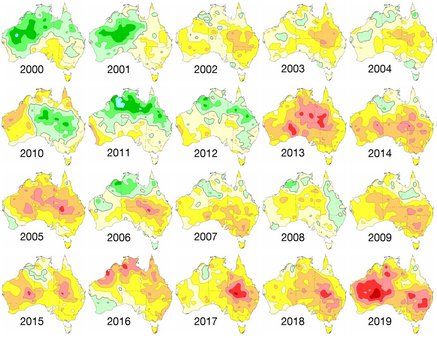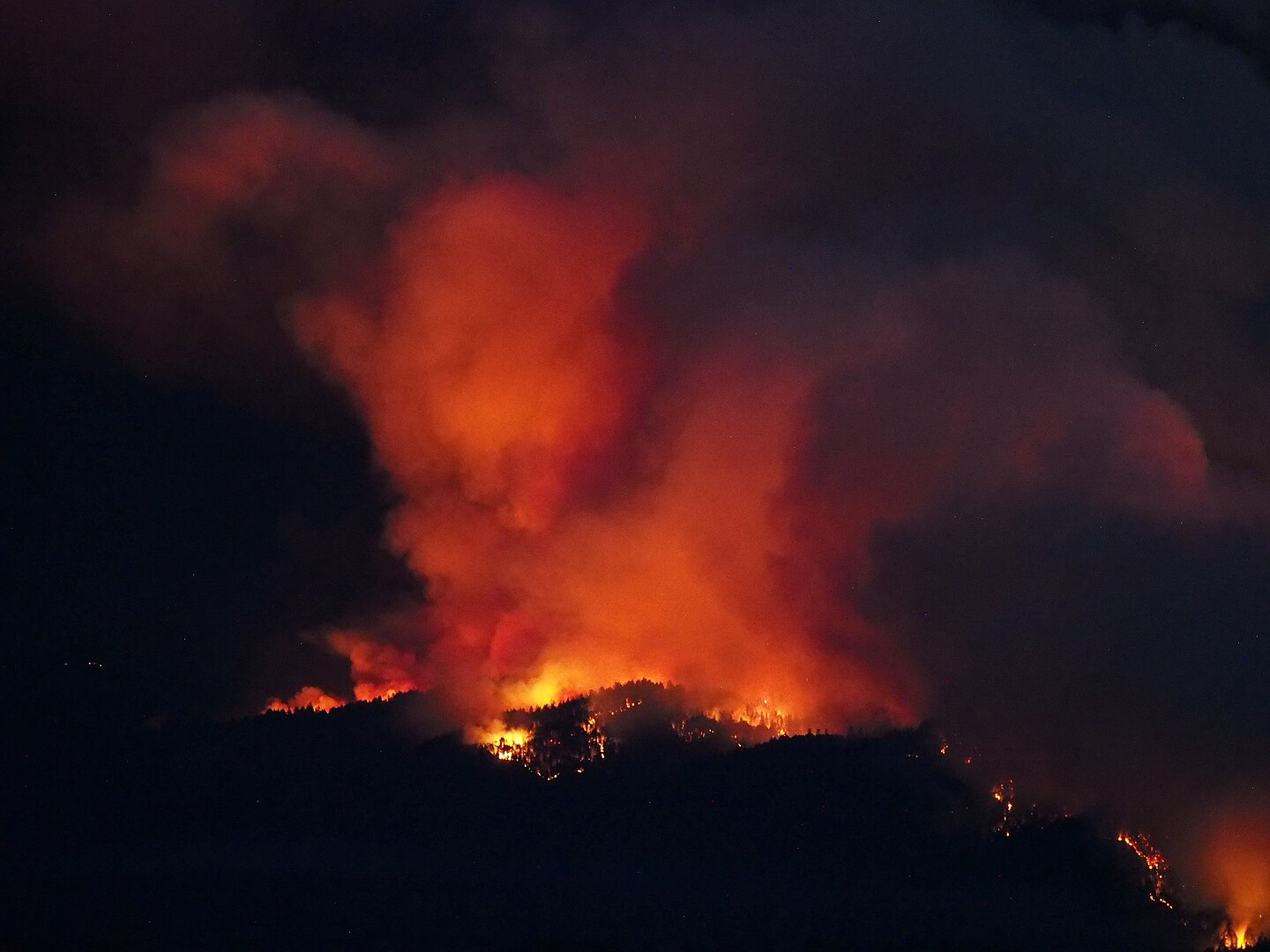Wildfires are more than local disasters—every blaze leaves a lasting impact on the planet. As wildfires rage across regions like North America, Europe, and Australia, they release greenhouse gases, change landscapes, and disrupt ecosystems. But here’s the catch: climate change makes wildfires worse, and wildfires, in turn, accelerate climate change.
It’s a dangerous feedback loop that we can’t afford to ignore.
At exci, we know that proactive solutions are critical to breaking this cycle. Let’s explore how wildfires affect our climate—and how exci’s AI-powered wildfire technology can help mitigate these impacts.

BOM Australia Mean Temperature 2000-2019
The Wildfire-Climate Connection
Climate change creates a perfect storm for wildfires. Rising temperatures and drier conditions turn forests into tinderboxes, leading to more frequent and intense fires. As these wildfires increase, they emit vast amounts of carbon dioxide (CO₂), fueling a self-reinforcing cycle: more fires elevate warming, which in turn triggers even more fires.
Over the past two decades, wildfires have released approximately 8 billion tons of CO₂ annually, which is about a quarter of the global CO₂ emissions reported in 2017. However, regrowth in burned areas helps offset part of these emissions, so wildfires are estimated to contribute about 5 to 10% of total annual emissions.
Wildfires have long been part of Earth’s natural cycle, but human activity has intensified their impact. In the past, wildfire emissions were balanced within the carbon cycle. However, climate change and changes in firefighting practices have disrupted this balance, leading to rising temperatures, extended fire seasons, and consequently, higher greenhouse gas emissions.
The scale of these fires underscores their impact. For example, the 2017 wildfires in Northern California emitted as much CO₂ in one week as all of California’s vehicles produce in a year. Similarly, wildfires in California in September 2020 released over 91 million metric tons of CO₂ — more than the state’s annual power sector emissions. NOAA scientist Pieter Tans noted that a fire burning 500,000 acres can release as much CO₂ as six large coal-fired power plants in a year, highlighting the significant contribution of wildfires to the climate crisis.
Given these alarming statistics, it is clear that the escalating crisis highlights an urgent need for proactive measures for effective and sustainable forest management. While wildfires are a natural part of the ecosystem, protecting and restoring our forests is crucial for reducing carbon emissions. Healthy forests absorb CO₂, and reforestation efforts are essential to ensure they continue fulfilling this vital role.
Ripple Effects on Weather and Ecosystems
Wildfires don’t just impact the air we breathe; they also disrupt local weather patterns, creating a ripple effect that worsens fire conditions. For instance, research shows that smoke from large fires can cool the land while simultaneously speeding up winds across the U.S. This alteration in wind patterns can have far-reaching consequences. It can also interfere with monsoon rains in Southeast Asia, leading to drier conditions that make these areas more prone to wildfires.
In addition to weather disruptions, ecosystems suffer greatly from wildfires. They hinder the regrowth of native plants, which are crucial for maintaining biodiversity. When these plants struggle to recover, invasive species can take over. This shift can transform vibrant forests into dry grasslands, drastically changing the landscape and harming local wildlife.
Moreover, peatland fires have devastating effects, especially in regions like Alaska, Southeast Asia, and the Amazon. These fires release significant amounts of methane and CO₂, two potent greenhouse gases. As a result, they not only contribute to climate change but also create a cycle that increases the likelihood of future wildfires.
Aerosols: The Wildcard in the Climate Equation
Wildfires release aerosols—tiny particles suspended in the air—that have a complex impact on our climate. These aerosols can cool the local environment by reflecting sunlight back into space. However, they can also trap heat, particularly black carbon produced during hotter fires. This interplay of particles can significantly alter rainfall and wind patterns, affecting climates far beyond the fire’s immediate area.
For example, Australia’s wildfires during the 2019-2020 season released massive amounts of smoke that may have influenced global climate patterns by intensifying the Pacific-wide La Niña, demonstrating how wildfire emissions can have far-reaching consequences.
To grasp the full climate impact of wildfires, researchers have analysed their effects across different time scales and atmospheric levels, from the surface to the stratosphere. In the lower troposphere, we see warming due to rising CO₂ levels. Conversely, the stratosphere experiences cooling because thinner air allows carbon dioxide to release energy into space.

Interestingly, it was previously believed that only volcanoes or nuclear explosions could send smoke into the stratosphere. However, large wildfires can create pyrocumulonimbus clouds (pyroCbs) under certain meteorological conditions. These powerful clouds can inject smoke 8 to 14 kilometres (five to nine miles) into the atmosphere, releasing aerosols that can travel globally.
Research has shown that smoke from the pyroCb outbreak in Australia raised stratospheric temperatures by up to 10°C (18°F) shortly after formation. Remarkably, temperatures remained about 3.5°C (6.3°F) warmer for several months before the aerosols settled back to Earth.
The Hidden Impact: Landscape Changes
Wildfires leave deep scars on the landscape. Initially, burned areas may reflect more sunlight as grasses and shrubs begin to regrow, creating a temporary cooling effect known as the albedo effect. However, as denser vegetation returns, these areas gradually lose this reflectivity, potentially leading to increased warming over time. Without the dense forest canopy to provide shade and store carbon, these areas can experience increased warming until the forest fully recovers.

In addition to altering light reflection, wildfires disrupt a crucial natural process called transpiration. Healthy plants release water vapour into the air, which helps cool the surroundings. When wildfires destroy vegetation, this cooling mechanism weakens, contributing to higher temperatures long after the flames have been extinguished. Research indicates that average surface temperatures can remain elevated for at least five years due to reduced transpiration.
Beyond the visible landscape damage, wildfires cast a much wider environmental shadow. The particles and gases they release travel vast distances, creating ripple effects that reach some of Earth’s most fragile ecosystems.
The Arctic Connection
The effects of wildfire emissions extend far beyond their immediate surroundings; they can even influence global systems. For instance, soot from wildfires can travel all the way to the Arctic, where it darkens ice and accelerates melting.
A striking example occurred in 2012 when pollution from wildfires significantly contributed to record surface melting of the Greenland ice sheet. Using satellite data, Ohio State University geographer Jason Box tracked soot particles from tundra wildfires reaching Greenland. The darkened ice lost its ability to reflect sunlight, leading to accelerated melting. In just four days that July, a remarkable 97% of the ice sheet showed signs of thaw.
As wildfires increase in the Northern Hemisphere due to climate change, emissions from areas like Greenland and Sweden could further exacerbate Arctic melting.
These impacts underscore the urgent need to prevent wildfires. By protecting our landscapes, we can help limit dangerous climate change and maintain the balance of our ecosystems.
A Path Forward: exci’s AI Wildfire Detection
Reducing wildfire devastation starts with one simple step: rapid detection. The faster a fire is identified, the quicker the bushfires can be attacked. exci’s advanced AI-powered wildfire detection technology focusses on just that – spotting wildfires within minutes to enable swift action before they escalate.
Powered by deep machine learning, exci’s advanced AI analyses camera data and satellite images for early smoke and heat signatures. When a fire is detected, exci instantly sends alerts to firefighting teams. exci’s system enables customers to immediately access live camera feeds to assess the situation in real-time. This direct access enables quicker decision-making, allowing rapid response and initial attack procedures.
Working Together: Breaking the Cycle
Tackling the wildfire-climate crisis demands collaboration and a shared commitment to our planet’s future. We must advocate for robust policies that protect our forests, implement smarter firefighting strategies, invest in reforestation, and embrace innovative solutions like exci’s early forest fire detection technology.
Controlled burns, when managed effectively, can also play a crucial role in reducing the risk of catastrophic wildfires while keeping emissions in check.
At exci, we are passionate about being part of the solution. Our Australian-made AI-driven bushfire & wildfire detection system provides real-time monitoring, empowering a diverse range of customers—including forestry operations, plantations, power companies, telecommunications providers, and agricultural landowners—to take proactive steps against wildfires.
Together, we can transform the way we manage our landscapes and prevent wildfires from escalating into climate disasters. Let’s join forces to protect our environment for future generations and create a more sustainable world.
by Gabrielle Tylor
exci – Smoke Alarm for the Bush
Proven Early AI-Powered Bushfire & Wildfire Detection Technology
Don’t let Hazardous Events become Catastrophic!
exci has evolved from delivering AI-powered wildfire detection to offering a complete turnkey solution. By expanding our services, exci offers a One-Stop Solution for comprehensive bushfire detection, management, and network connectivity. Proudly Australian-made and owned, we provide a complete package that includes:
- AI-driven detection for fast, accurate and reliable early wildfire detection
- Expertly designed and installed hardware for seamless fire monitoring
- Custom tower solutions tailored to your specific location and needs
- Complete expert installation and maintenance services
- Real-time camera access and control allow immediate situational awareness and informed decision-making during wildfire events.
Secure your assets, enhance your fire response capabilities, and experience peace of mind with exci’s innovative AI forest fire detection and monitoring service.
Contact us today to discover how we can tailor our AI-powered wildfire/bushfire detection and network solutions to suit your unique needs.
Email: info@exci.ai
International: +61 458 594 554
Australia: 1300 903 940

